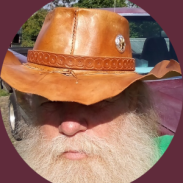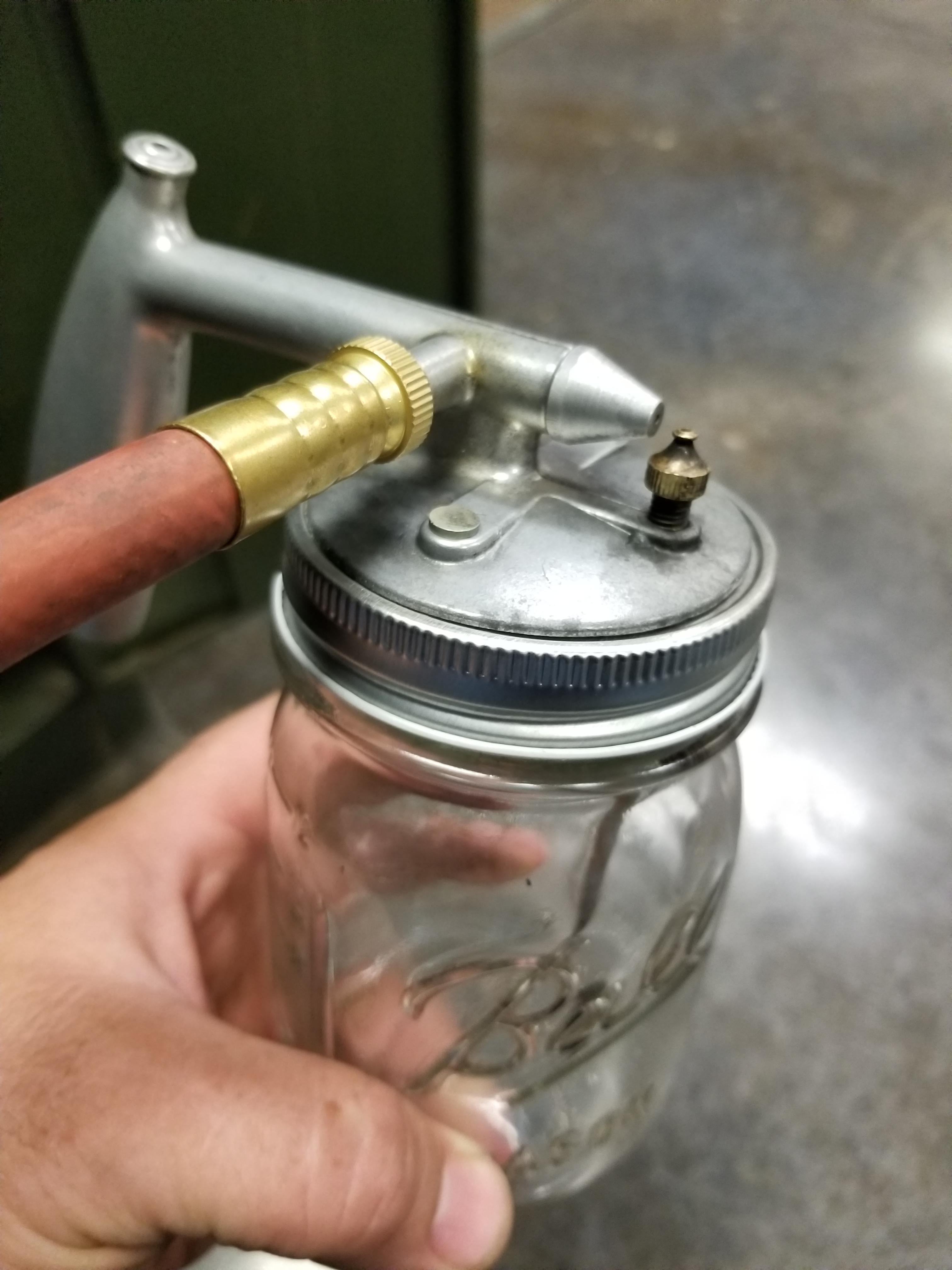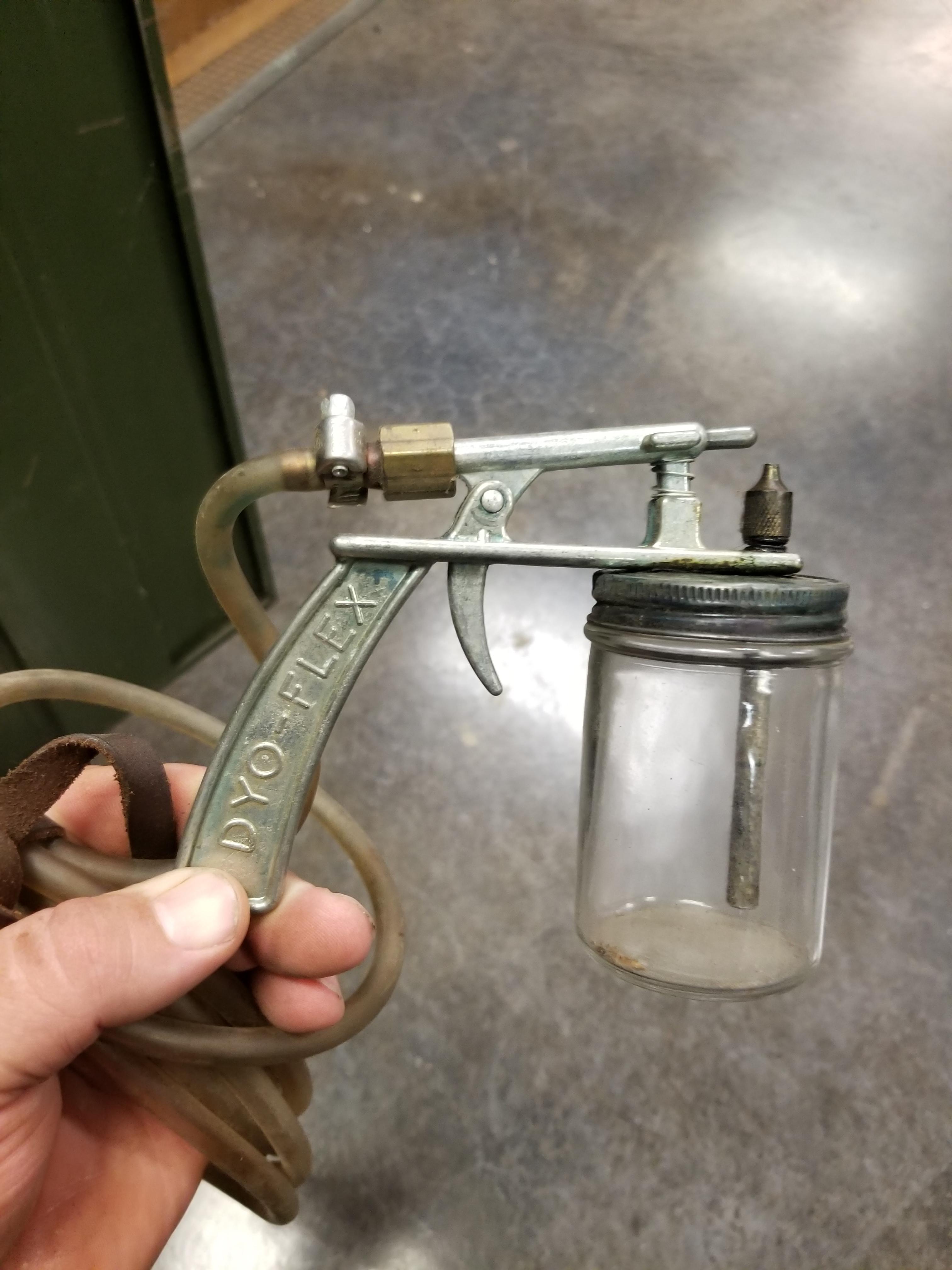All Activity
- Past hour
-
That's pretty neat! I do just plan on doing the moc toe stitch by hand though. There's no real useful way for me to make it happen via machine Apologies, I had written up a draft and asked ChatGPT to clean up my ramblings and incoherencies. I meant to say that I've seen vinymo #5 compared to 138, which didn't make sense to me. It seemed much bigger. But, it still does go through my CLSP.
-
Development of best servo motor for leather sewing machine
GerryR replied to CowBoyOUTLAW's topic in Leather Sewing Machines
I know, I just wanted him to say it. I still prefer VFDs with 3-ph gear motors over DC systems. JMO, YMMV. -
I appreciate the rundown on airbrushes. I definitely learned some things, but for the few times a year I'd use one, I'm not buying, maintaining and trying to remember where I put, an airbrush. I'll post back here if I get passable results. Overspray and spatter might make me happy. Perfection is just terminally boring.
-
Mbnaegle has pretty well summed it up. A spray mister is not going to give you much control over the area being "sprayed" or allow any sort of detail work. The external mix airbrushes are the best option for what you want to do, they're simple to use, easy to clean and inexpensive. Where I live they often come up on Marketplace pretty cheap.
-

Development of best servo motor for leather sewing machine
dikman replied to CowBoyOUTLAW's topic in Leather Sewing Machines
Gerry, my understanding is that it's simply a Hightex 750w servo with 12 coils to give it lower startup speed and low-end torque, nothing more (other than a higher price because of the extra coils). I still believe that unless someone goes down the path you have to obtain effective slow-speed control and torque then a speed reducer is needed with a servo used for leatherwork (particularly with the big harness stitchers). -
Incorrect: 0.6mm thread is just slightly smaller then V346 ( T350). Reference Chart use ( https://www.tolindsewmach.com/thread-chart.html ). To handle thread above V207 you need a Juki TSC-441 or clone similar to the CB4500 or a one armed bandit like the Cowboy Outlaw, Tippmann Boss or the Weaver Cub. kgg
- Today
-
I WILL TAKE ANY REASONABLE OFFER. Hello, I am selling Camoga C400 leather splitter. I can't use it at new location as i don't have a three phase hook up. Motors were rewound to 230V from 380V. I tried to use static phase converters as you can see on pictures. They are to weak for this machine. I will remove them upon sale. Machine is located in GLASCOTT ONTARIO, CANADA. I can quote and ship within Canada and USA. $ 2000 USD. Thanks Jack
-
I will take any reasonable offer.
-
I WILL TAKE ANY REASONABLE OFFER. Hello, I am selling heavy duty cylinder arm, made in japan, SINGER B8BC ( Seiko CH-8B ) sewing machine used for making leather goods. In excellent working condition. Serviced regularly. Made in Germany EFKA DC1550 motor SINGLE PHASE 230V (its NOT 3 phase) with speed reducer. Lotsa spare parts and bobbins. $$2000 USD Machine is located in GLASCOTT, ONTARIO, CANADA. I can quote and ship within Canada and USA. I can split shipping cost to some degree. More info and specs about this machine : https://www.industrialsewmachine.com/webdoc1/singer/45b.htm Thank You Jack
-

Sewing machine for true moccasin footwear
mbnaegle replied to X24's topic in Leather Sewing Machines
Not sure if this is what you are after as I have I've no experience in shoe or moccasin making, BUT something maybe of interest is that in the 1950's there was an Indian moccasin fad big enough that the American Stay Co. (later sold to Randall) developed a moccasin seam sewing attachment for the Union Lockstitch machine (Needle and Awl Harness stitcher). To mount it, the machine's face plate and the awl bar had to have some extra features machined into them, but most every machine made from the 1950's to the 1990's had those features ready to use. Essentially what this attachment does is replaces the up-down pressure foot motion with a left right pressure, pushing the material into the channel of a special needle plate. The pressure bar (LS-801) could be inserted into the shoe, allowing the moccasin's upper seam to be sewn. We haven't sold parts for these in decades, but still have it all on the shelf and It's been on my to-do list to set up a machine with one and try it out. -
it is pretty cost effective, and common easy finding retail store, and I like the softer HDPE for punch, been using it for many years . HDPE is great and cheap for abusing for a backing when punching . But.. 'cutting' on HDPE surface, it takes a BAD beating . I was just at the supply warehouse yesterday picking up some more 4x8 sheets of ABS and HDPE, and while I was there was looking and pricing the Actalcopolymer sheets ( For Cutting ) not punching . If you ever are going to 'UpGrade' to a 100 x superior material for a 'cutting surface' board . Buy Acetal Copolymer ( Polyoxymethylene ) . Very Similar structure to Derlin, but it not Derlin and is a little cheaper in cost over Derlin. . OK, quick search . . here a simple vid. of what I am saying . the Vid. got A Lot of OP Jibber-Jabber knife talk . so I started into the Vid. 4: 17 minute . Cut Surface -
-
Forgot that you have two hand wheels! Or one giant handwheel and two motor pulleys (one on the motor, one one the patcher). This is going to mess up my terminology notes for sure 🤷♂️ From your video, I'm not sure if that lateral motion is a problem, a feature, or neither. Is there anything along the main shaft that looks like it's intended to impede this lateral motion?
-
I've not had serious work place accidents. The worst I've had was dropping a 5lb club hammer on me foot. It missed the steel toe cap of the boot and got the foot where it was unprotected I've done plenty of things that should have put me in hospital or the morgue. Like lighting up a ceegar in a paint spraying area just after the painter chap had done a lot of cellulose paint spraying. That only blew the door and a window open. Or my mechs and I used to race the garage heaters down the drive. The space heater worked like a jet engine in reverse; a small air intake pulled air thru to a sparking plug and a mixture of paraffin oil, and hot burning gasses out the rear end. We found we could turn the process around and have a jet engine. Strapped to a mech under-car dolly it could shift. So we raced them. They needed electricity for the sparking plugs so we fitted the same length of cable to each. Fired them up and sent out of the workshop and down the drive way. Of course the cable pulled out but the rockets would go on further. The record was 175 feet. It would have been further but a small ruined cottage got in the way. Had several police visits about 'mysterious' objects flying about Got all me fingers and toes, but the hearing ain't so good. 35 years of riding noisy motorcycles and 30 years of attending noisy motor sports has ruined it. I tried ear plug a couple of times but it seriously affected my sense of balance and I nearly crashed with them in. Never used them after that
-
Hey all, I’m looking for sewing machine recommendations. I know there’s probably no perfect solution for my needs aside from owning multiple machines, but I’d love to hear input. I’ve been working on true-moccasin style bootmaking—basically trying to mimic Russell Moccasin’s approach as closely as possible. This involves sewing 3D lines with partially assembled components getting in the way. I’ve been managing with a hand-cranked CLSP, which has done surprisingly well with some planning and tinkering, but it’s not ideal. Here’s my bootmaking Instagram for reference: 📸 x24_leathers Some challenges: Heel stay: Very 3D—standard cylinder arms don’t offer the articulation I need. A post-bed machine would likely shine here. Quarters to vamp / molded sole to upper: These need a cylinder arm. A post-bed can’t manage this geometry. Russell uses a range of machines—Puritan chain stitch, post-bed, cylinder arm, etc.—but I don’t have their resources. I’ve been eyeing a motorized 29k clone. I know it’s a patching machine, not a production machine—but the general concept (rotating arm, slim profile) actually works well for my use case. That said, its 6mm punch capacity and basic walking foot feed seem limiting. Ideally, I want to upgrade from the CLSP to something that retains its versatility, handles moderate 3D work, and can sew with #5 Vinymo MBT (about 0.6mm; slightly thicker than size 138). I currently use: 120/19 needles for <3mm material 130/22 needles (these: Amazon link) for >3mm Any recommendations or insights are appreciated. Thanks!
-
Garden plant sprayers are cheap. Available in plastic or glass. Get a cheapo plastic one to try out. I have 5 or 6 glass ones, cost £1.50 per about $1.75 each, you can probably get them cheaper. I opted for the glass as its easier to clean after the dyeing. Dye doesn't stain glass like it does plastic They're easy to clean. I put the spray head on a spare bottle (it actually doesn't need to fit ) and spray alcohol thru it until it sprays clean. A quick wash then in soapy water finishes the job. If you can find a lid that fits the spray bottle you can keep the dye in it for future use
-
ohh that happened to moi too, but it was huge amplifier. I got thrown 30ft. Wud have been more but the wall I hit stopped me! I'm keeping my sewing machines caged! Dangerous beasties that they are
-
Might depend on what kind of air-brush you were using, but more so what you are doing. There are lots of different kinds that work different ways. Some take more skill and provide better detail control, while others are simpler. For basic painting where I'm not getting too "artistic", I'm a fan of the Binks Wren airbrushes (expensive new, but cheap used), though that general design concept is offered by other makes as well. It's a externally mixing gun, meaning it's like an air gun with a tube in front of the nozzles that siphons paint up out of the pot, making for easier cleanup. It's also a single action button, where pressing the button only activates the air. Other airbrushes out there like my Badger 150's are double-action, where pressing the button activates the air, but pulling back on the button gauges how much air is coming out, which can be tricky to get the hang of. All of mine are syphon feed that need air to pull the paint/dye up a tube, while others are side or top gravity feed. I think a spray bottle would be hard to gage when to start and when to stop pumping, how to fade it, etc. but I've never tried using one for paint or dye. I think they would be hard to clean, so it ends up being a disposable. Air-powered spray guns have the advantage of providing consistent pressure for as long as you hold the button or trigger. If you're looking for simplicity and need to do volume, these old dye sprayers are about as simple as they come. Not sure where to buy them these days, but it gives you some ideas. This one I recently restored, (full of dry dye and the lid was rusted out). No moving parts and minimal cleaning needed. It uses very little air pressure, which bleeds out a hole in the top of the handle. When you cover that hole with you're thumb, it redirects the air to spray out the front. Not sure who made it originally. Also have a couple of these old Dyo-Flex guns. The air is always spraying out the front and the trigger moves it closer or farer from the syphon nozzle, changing if or how much fluid is spraying.
-
Should You Repair Your Leather Furniture or Buy New?
Leather Repair Center posted a blog entry in Leather Repair Center
Leather furniture adds timeless elegance, comfort, and character to any space, but what happens when it starts to crack, fade, or tear? Many homeowners face the same question: Should I invest in leather furniture repair, or just buy something new? Before you rush to replace that worn sofa or scuffed recliner, here’s what you need to consider — and why leather furniture repair might be the smarter, more sustainable choice. 1. What’s the Real Cost of Buying New? Quality leather furniture isn’t cheap. A new genuine leather couch can easily cost $2,000–$5,000 or more. If the frame and structure of your current piece are still solid, replacing it might mean spending thousands of dollars unnecessarily. By contrast, leather upholstery restoration typically costs just a few hundred dollars and can make your furniture look almost new again. 2. Can It Be Repaired? You might be surprised by what can be fixed: Cracks and fading from sun exposure Scratches and pet damage Small punctures or tears Dull, dry, or stained leather Separated seams or worn cushions If the damage is only surface-level, professional leather furniture repair can fully restore the look, feel, and durability, saving you time, money, and hassle. 3. What’s the Sentimental or Style Value? Some furniture has personal or aesthetic value that can't be replaced. Maybe it’s a custom color, a perfectly worn-in shape, or a sentimental piece passed down from family. In these cases, leather upholstery restoration allows you to preserve what you love while giving it new life. 4. Environmental Impact Matters In a city like San Francisco, sustainability is more than a trend — it's a priority. Repairing instead of replacing reduces waste, conserves resources, and supports a more eco-conscious lifestyle. Every time you choose restoration over replacement, you're making a decision that’s better for the environment. 5. When Should You Replace? There are times when buying new may be the better option: If the frame is broken or the structure is unstable If the furniture is extremely outdated and doesn’t suit your needs or space If the cost of restoration exceeds the value of the piece Still, these cases are the exception, not the rule. Final Thoughts Before you haul that old sofa to the curb or start browsing for a new sectional, consider your options. Leather furniture repair is affordable, fast, and eco-friendly. With expert leather upholstery restoration, your favorite chair or couch can look and feel brand new, for a fraction of the cost of replacing it. Want to know if your leather furniture is a good candidate for restoration? Visit Leather Repair Center to learn more or request a quote today. -

Some exotic inlay for 1911
Stetson912 replied to Stetson912's topic in Gun Holsters, Rifle Slings and Knife Sheathes
You can use 8 oz for the panel then cut v the window from 4 oz and glue it on top. The skiving of the window panel reduces the thickness on the "wings" making it a bit cleaner and I think more comfortable. You need the 8 oz for the holster structure. I jmloke using the 2 layers of 4 oz laminated because it gives me a liner and is a bit stronger. You could take your 8 oz and make the front panel rough out and then the window on top, but then you would have to line the back panel or have a half lined holster hahaha -
Sams Club sells commercial cutting boards. I cut them up with a table saw to get smaller pieces. Great for backer board while using a hole punch and relatively cheap. I think they are about 20x24 inches or so.
-

Some exotic inlay for 1911
fredk replied to Stetson912's topic in Gun Holsters, Rifle Slings and Knife Sheathes
Not as simple a construction as I thought Well done






